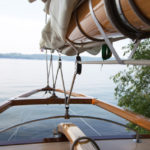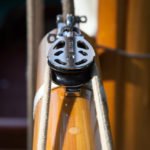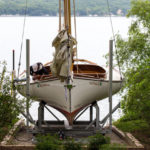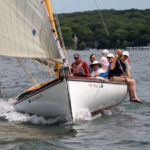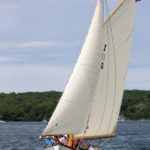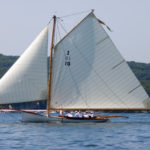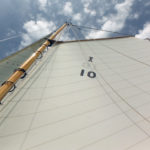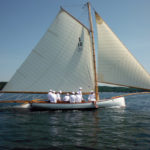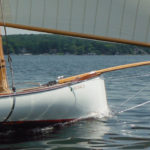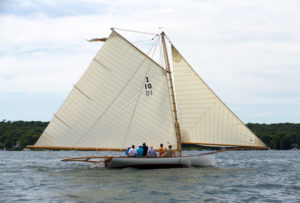
“Tattler II” may appear to be a strict turn-of-the-century sandbagger replica. But look closely. And you’ll see she blends classic idioms with modern materials much like …
It’s the question that defines this wee and wonderful Spirit-of-Tradition design world of ours: What exactly is the line between a lovingly restored historic replica, and a true blended modern-classic, Spirit-of-Tradition yacht? We had a clever idea: why not sit down with an owner of just such a period replica, and ask his perspective.
Let us introduce you to Charles Colman, an amiable mid-westerner who does most of his sailing on Wisconsin’s Lake Geneva. And this otherwise reasonable fellow has spent the past several years pouring his heart and soul into recreating a turn-of-the-century sandbagger design, called Tattler II.
All you replica purists should know that Colman did what we in this shop almost never do: He sought to recreate the past as accurately as he could. Instead of working from a broken down beater of a hull, Colman found a storied classic sandbagger design that told a validatable story dating all the way back to the summer of 1892. He then hired a mid-west builder, fluent in the local design idioms, namely our friends over at Van Dam Custom Boats, in Boyne City, Mich. Colman then traveled with Ben Van Dam to Annapolis, MD., to view two original sandbaggers and acquire original plans. The team at Van Dam then modeled those plans and survey data up into working construction drawings, using modern design software. From all that, Colman then had an apparent replica built, from scratch!
Safe to say, no throwback style points were left on the table with Tattler II.
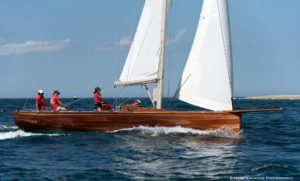
… our contemporary, Spirit-of-Tradition yacht, “Racehorse. ” The difference? Each client asked slightly different design questions.
You might expect Colman to play the role of strict purist, when it came to his faithful re-creation of a century-old vessel. But that’s not him. Instead, Colman’s story is all about the sensitive compromises he made to get Tattler II on the water and sailing in 2016. To Colman, his strict period replica is not a design-and-build no-brainer. In fact, solving Tattler II was eerily similar to how we solved our far more contemporary takes on the sandbagger design: the W-37 Racehorse, pictured to the left. Both are finessed from today’s materials. Both had to obey today’s rules for prudent sailing. And both had to keep today’s sailors alive and comfortable.
What Colman found is what we have found: No matter the vessel, owners and builders have no choice but to use their intelligence and taste to blend their understanding of modern engineering with the classic naval narratives they hope to explore.
To learn exactly how, let’s sit back and enjoy the story of The Making of Tattler II. And how she forced Charles Colman to master the present in order to go back to the past.
An E-Scow Sailor Looking to Bring Back History.
Charles Colman knew his days as a competitive E-Scow racer up on the northern shore of Wisconsin’s Lake Geneva, near Williams Bay, were winding down. Even though he had raced in these waters his whole life, Colman was creeping dangerously close to the middle-aged sailor’s nightmare of younger, more athletic teams “always beating his brains out.”
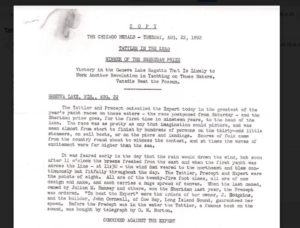
Big sailboat races were big news back in the day. The original Chicago Herald Tattler copy, circa 1892.
As Colman began to look for fresh sailing adventures, his imagination went back to sandbaggers. Those ultra-fast and dangerous lake racers he’d grown up dreaming about. One of his favorite sandbagger legends was how, all the way back in 1892, two ridiculously over-canvased speedsters, Precept and Expert, raced for something called the Sheridan Cup, named after Civil War hero General Sheridan. These were the hot summers of mid-Wisconsin boat racing: After the Chicago Fire in 1871, the wealthy and the wannabes that drive sailboats to go ever faster, came to this big lake to relax, stay cool and race their boats. Big city media, like The Chicago Herald, ate the sailing action up. Real money was spent on sending real reporters to cover the biggest of the sandbagger races.
And as Colman likes to tell it — and he’ll send you a copy of the Chicago Herald clipping from back in the day, if you ask nicely — on that summer of 1892, a dramatic unnamed new day-racer appeared on the lake. Word was, she was ordered by telegram and brought in overland from a skunkworks boatyard out east. Early photos still survive of this then-mystery racer: You can see her, hidden under an obloid squash-court-sized slab of canvas: An original 28-foot oyster boat hull, dramatically flared at her beams to skim like a bug over the lake’s flat water. This beast of canvas and wood touched almost 56 feet in length from bowsprit to boomkin. And took something like 12 professional sailors — and a few dozen sandbags — to keep her upright, much less competitive. Word was, she would spend her summer sharpening her sailing axes, to hunt down Precept and Expert, and take these sandbaggers out on race day.
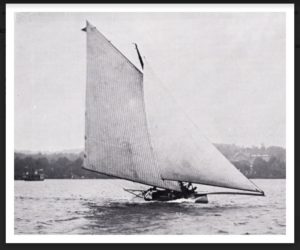
The original Tattler, going to windward. Date unknown.
And so it was. On Aug. 22 at 11:30 a.m. — after a postponement due to rain the day before — the historic sandbagger smackdown was on. Hundreds packed into 30-odd steamers, day boats or along the shore to watch the mystery ship — now fully christened as Tattler — take on Precept and Expert. The boats were off, and the battle began. During the first seven-mile leg, cries of “Anything to beat the Expert” were heard out along the water as the boats battled for position. But at the turning mark, the “fair fight began” and Tattler was the clear performer. Her monster sails and wider beam gave her the decisive edge. And she pulled away slowly but surely, besting the other boats by almost five minutes in a roughly three-hour race.
Lake Geneva had its champion and its favorite story. And Charles Colman would not be the one to not give that tale its due.
Charles, are you Crazy?
When it came time to finally move on from scow racing, starting around 2013, Colman knew that keeping the Tattler legend alive was that quiet obsession that would not fade. And if he was going to bring Tattler back, he knew he would have to do it just right. So Colman started with people he knew. Boat builders, Ben and Steve Van Dam from Van Dam Custom Boats, who built a day launch called Nokomis that Colman owned and treasured. Discussions began with the Van Dams on how to bring Tattler back to life. After trips out east to loft the original sandbaggers, confirm the build philosophy, and create working plans, Colman got a serious call from Steve Van Dam.
“He called me back and said ‘Charles, are you crazy?,” laughs Colman.
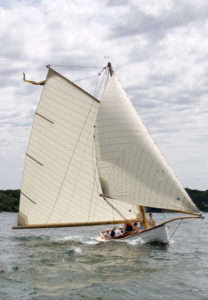
Today’s Tattler II can handle a reasonable breeze. Not so the original, which could capsize in just 6 knots of wind.
Van Dam had reason to worry. There were major safety and construction issues that revolved around just how accurately Colman expected his Tattler II to follow the original boat; that boat was built with planks over bulky frames, a technique that Van Dam flatly rejected as awkward, heavy and impossible to maintain. Also, the original centerboard was made of wood, making it essentially useless in a modern boat. The rigging also had no winches, few blocks and featured dangerous stranded wire that could easily sever fingers. Then there were the basic usability questions. The first Tattler was designed for a dozen professionals. No modern sailor would want to manage that level of crew hassle. Colman quickly realized that it wasn’t a question of willingness to make Tattler II different from the original, it was about balancing the past with what was reasonable in the present.
“You had to catch the characteristics of the boat to have that original feeling,” he explained. “But I had to be able to sail it, for heaven’s sake. I wanted a beautiful, modern boat that lasted forever.”
The abstractions of making new materials feel like a classic boat became all too real to Colman when a naval engineer flatly told him Tattler would capsize in anything more than six miles an hour of wind. Considering it takes a barge and a crane to right a boat like Tattler, that was not a risk an insurance company would accept. In fact, the period sandbaggers that exist today often reduce their sail area by around 30 percent to make them sailable in today’s risk-averse world. But Colman felt that reduction was far too severe.
“It would not be the spirit of the sandbagger if you cut the rig too tight,” says Colman. “It would look weird.”
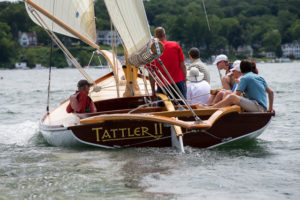
The basic hull shape and cockpit arrangement are like the original. But most everything for sail handling on Tattler II was updated for safety and ease-of-use.
A compromise was made: Reduce Tattler II’s sail area by 15 percent and look for stability and safety in other ways. Van Dam and Colman got respectfully inventive. The original wooden centerboard, which goes down 5 feet, would be recast in lead, adding about 1,400 pounds of ballast. Modern rigging, blocks and ratchets were not available in the proper materials. So they were handcrafted from stainless steel and installed to ease the managing of the still seriously-powerful sail plan. Hand-crafted stainless steel dead eyes were also installed to control the light aramid-fiber rigging, that removed the dangerous wire from the rig. Tastefully disguised aramid stays were employed and modern line clutches were carefully engineered to not be seen. So even though hi-test cored sheets and halyards were used, they were carefully selected out of traditional colors, and fitted to avoid spoiling the period feel of the rig. Lazy jacks and topping lifts were also made out of modern lines, and a long deck-sweeping boom was installed that relied on its weight to keep sail shape in a breeze. And although modern Dacron sail cloth was used in the Tattler II’s wardrobe, a cream color was chosen for aesthetics and the panels were cut narrower than normal to give the sail a more period look.
And then, the entire hull — as classic and historically pure as it appears — was actually built using modern wood laminate techniques. Van Dam could then explore woodworking details that never existed on the original: mahogany centerboard case, a modern laminated tiller, a bowsprit and boomkin. And a carefully tapered, hallow-tube laminated spar. Structural anchors and attachment points for each was carefully crafted out of modern composites and metals. And on top of all that, Van Dam worked in its signature hand-selected, matched-grain woodworking for the cockpit coaming, toe rail and scuppers — all of which were finished with state-of-the-art sealants and paints.
The final 21st-century touch? Modern electric propulsion. A silent motor was the only way to push Tattler II safely through the harbor. Nothing like that was anywhere close to the original design.
The “Spirit-of-Tradition” Replica.
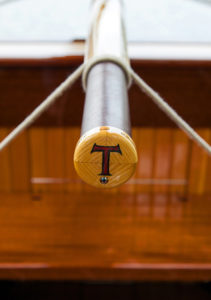
The build detail on Tattler II was unheard of on the original boat.
By all accounts, Colman got his 1892 story just right with today’s Tattler II. This boat does not deliver a beginner’s sail on the lake. As with the original, this seriously fast daysailer is easily overpowered. Colman takes precautions to only sail most days with less than a 15-knot breeze. Strong mainsail and jib trimmers are a must, and Colman still has to find someone with the guts enough to climb out on the 15-foot bowsprit when the jib hanks jam. There are no life lines.
Yet, Tattler II is comfortable and elegant for those who know how to sail her. Colman says a fabulous afternoon can be had for four to eight reasonably good sailors. As Colman tells it, most people talk about how hard modern sailing has become, yet how exciting and relaxed Tattler II can be.
“We might get five boats trailing you all around the lake,” says Colman. “It’s a way to enjoy lake sailing history while having a great time on the water. There is no boat like it.”
